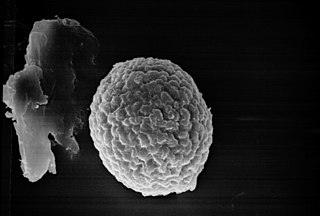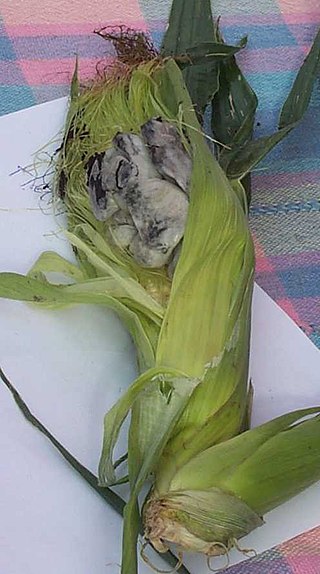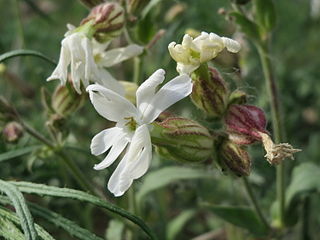
Basidiomycota is one of two large divisions that, together with the Ascomycota, constitute the subkingdom Dikarya within the kingdom Fungi. Members are known as basidiomycetes. More specifically, Basidiomycota includes these groups: agarics, puffballs, stinkhorns, bracket fungi, other polypores, jelly fungi, boletes, chanterelles, earth stars, smuts, bunts, rusts, mirror yeasts, and Cryptococcus, the human pathogenic yeast.

Rusts are fungal plant pathogens of the order Pucciniales causing plant fungal diseases.

The smuts are multicellular fungi characterized by their large numbers of teliospores. The smuts get their name from a Germanic word for 'dirt' because of their dark, thick-walled, and dust-like teliospores. They are mostly Ustilaginomycetes and comprise seven of the 15 orders of the subphylum. Most described smuts belong to two orders, Ustilaginales and Tilletiales. The smuts are normally grouped with the other basidiomycetes because of their commonalities concerning sexual reproduction.

Karnal bunt is a fungal disease of wheat, durum wheat, and triticale. The smut fungus Tilletia indica, a basidiomycete, invades the kernels and obtains nutrients from the endosperm, leaving behind waste products with a disagreeable odor that makes bunted kernels too unpalatable for use in flour or pasta. While Karnal bunt generally does not lead to devastating crop losses, it has the potential to dramatically decrease yield, and poses additional economic concerns through quarantines which limit the export of suspected infectious wheat products from certain areas, including the U.S. Several chemical control methods exist for Karnal bunt of wheat, but much work remains to be done in identifying resistant host varieties.

Bouteloua dactyloides, commonly known as buffalograss or buffalo grass, is a North American prairie grass native to Canada, Mexico, and the United States. It is a short grass found mainly on the High Plains and is co-dominant with blue grama over most of the shortgrass prairie. Buffalo grass in North America is not the same species of grass commonly known as "buffalo" in Australia.

The Ustilaginales are an order of fungi within the class Ustilaginomycetes. The order contained 8 families, 49 genera, and 851 species in 2008.

The Ustilaginomycotina is a subdivision within the division Basidiomycota of the kingdom Fungi. It consists of the classes Ustilaginomycetes and Exobasidiomycetes, and in 2014 the subdivision was reclassified and the two additional classes Malasseziomycetes and Monilielliomycetes added. The name was first published by Doweld in 2001; Bauer and colleagues later published it in 2006 as an isonym. Ustilagomycotina and Agaricomycotina are considered to be sister groups, and they are in turn sister groups to the subdivision Pucciniomycotina.
Common bunt, also known as hill bunt, Indian bunt, European bunt, stinking smut or covered smut, is a disease of both spring and winter wheats. It is caused by two very closely related fungi, Tilletia tritici and T. laevis.

Loose smut of barley is caused by Ustilago nuda. It is a disease that can destroy a large proportion of a barley crop. Loose smut replaces grain heads with smut, or masses of spores which infect the open flowers of healthy plants and grow into the seed, without showing any symptoms. Seeds appear healthy and only when they reach maturity the following season is it clear that they were infected. Systemic fungicides are the major control method for loose smut.

Tilletia caries is a basidiomycete that causes common bunt of wheat. The common names of this disease are stinking bunt of wheat and stinking smut of wheat. This pathogen infects wheat, rye, and various other grasses. T. caries is economically and agriculturally important because it reduces both the wheat yield and grain quality.

Urocystis agropyri is a fungal plant pathogen that causes flag smut on wheat.
Sporisorium sorghi, commonly known as sorghum smut, is a plant pathogen that belongs to the Ustilaginaceae family. This fungus is the causative agent of covered kernel smut disease and infects sorghum plants all around the world such as Sorghum bicolor (sorghum), S. sudanense, S. halepense and Sorghumvulgare var. technichum (broomcorn). Ineffective control of S. sorghi can have serious economic and ecological implications.
Sporisorium reilianum Langdon & Full., (1978), previously known as Sphacelotheca reiliana, and Sporisorium reilianum, is a species of biotrophic fungus in the family Ustilaginaceae. It is a plant pathogen that infects maize and sorghum.

Puccinia monoica is a parasitic rust fungus of the genus Puccinia that inhibits flowering in its host plant and radically transforms host morphology in order to facilitate its own sexual reproduction.
Tilletia horrida, rice kernel smut, caryopsis smut, black smut, or grain smut, is a fungal rice disease believed to only affect the Oryza genus. It presents as a partial bunt.
Conidiosporomyces is a genus of fungi in the smut family Tilletiaceae. The genus was described in 1992 to accommodate the species formerly known as Tilletia ayresii, first described by British naturalist Miles Joseph Berkeley in 1899. The species C. verruculosus was described in 1993. Species in the genus are plant pathogens that affect various grasses.

Microbotryum violaceum is a host-specific anther smut (fungus) disease that infects Silene latifolia and sterilizes the host plant. When infected with this disease, the flowers generate pathogenic spores, which can then be transferred to other plants by pollinating insects. Therefore, this disease is sometimes classified as a sexually transmitted infection.

The Doassansiaceae are a family of fungi in the division Basidiomycota and order of Doassansiales. The family contains 11 genera and about 58 species. They have a widespread distribution. Doassansiaceae is also known and classified as a smut fungi.
The Melaniellaceae are a family of fungi in the division Basidiomycota and order of Doassansiales. The family contains 1 genera and 2 species. They have a distribution in south and south-east Asia.
Thecaphora frezzii, commonly referred to as peanut smut, is a species of smut fungus of the genus Thecaphora and the family Glomosporiaceae. It is a basidiomycete fungus that infects peanut plants. It is currently only found in South America, more specifically in Argentinian peanut farms.













